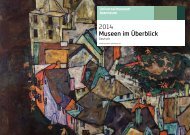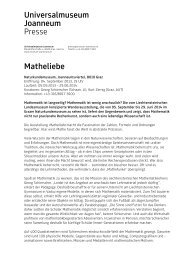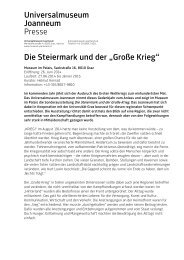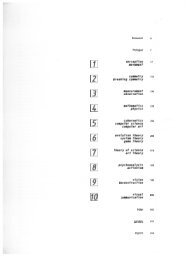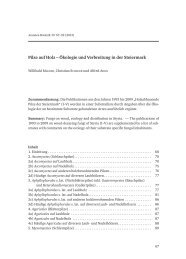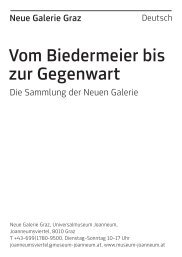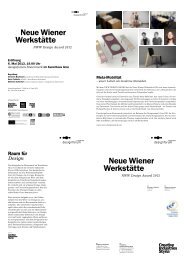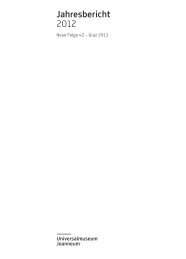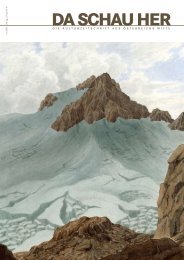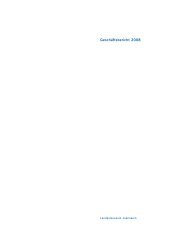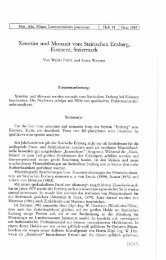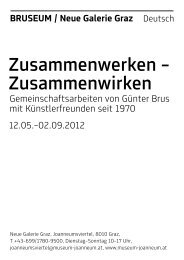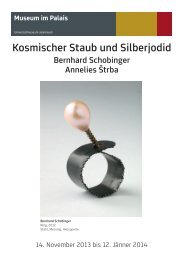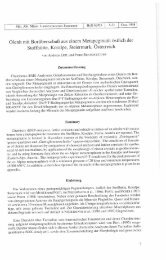Diana Thater gorillagorillagorilla - Universalmuseum Joanneum
Diana Thater gorillagorillagorilla - Universalmuseum Joanneum
Diana Thater gorillagorillagorilla - Universalmuseum Joanneum
Erfolgreiche ePaper selbst erstellen
Machen Sie aus Ihren PDF Publikationen ein blätterbares Flipbook mit unserer einzigartigen Google optimierten e-Paper Software.
If the problem then is one of defining the border – at once<br />
the separation and proximity – between animal and man,<br />
perhaps the moment has come to attempt to pin down the<br />
paradoxical ontological status of the animal environment<br />
as it appears in the 1929–30 course. The animal is at once<br />
open and not open – or, better, it is neither one nor the<br />
other: it is open in a nondisconcealment that, on the one<br />
hand, captivates and dislocates it in its disinhibitor with<br />
unmatched vehemence, and, on the other, does not in any<br />
way disconceal as a being that thing that holds it so taken<br />
and absorbed. Heidegger seems here to oscillate between<br />
two opposite poles, which in some ways recall the para‑<br />
doxes of mystical knowledge – or, rather, nonknowledge.<br />
On the one hand, captivation is a more spellbinding and<br />
intense openness than any kind of human knowledge; on<br />
the other, insofar as it is not capable of disconcealing its<br />
own disinhibitor, it is closed in a total opacity. Animal capti‑<br />
vation and the openness of the world thus seem related<br />
to one another as are negative and positive theology, and<br />
their relationship is as ambiguous a the one which simul‑<br />
taneously opposes and binds in a secret complicity the<br />
dark night of the mystic and the clarity of rational know‑<br />
ledge. And it is perhaps to make a tacit, ironic allusion to<br />
this relationship that Heidegger feels the need at a certain<br />
point to illustrate animal captivation with one of the oldest<br />
symbols of the unio mystica, the moth that is burned<br />
by the flame which attracts it and yet obstinately remains<br />
unknown to the end. The symbol here shows itself to be<br />
inadequate because, according to the zoologists, what<br />
the moth is primarily blind to is precisely the non‑open ‑<br />
ness of the disinhibitor, its own remaining captivated by it.<br />
While mystical knowledge is essentially the experience of<br />
a nonknowledge and of a concealment as such, the animal<br />
cannot comport itself toward the not open; it remains ex‑<br />
cluded precisely from the essential domain of the conflict<br />
between disconcealment and concealment.<br />
Nevertheless, in Heidegger’s course the animal’s poverty<br />
in world is at times reversed into an incomparable wealth,<br />
and the thesis according to which the animal is lacking in<br />
world is called into question as an undue projection of the<br />
human world onto the animal.<br />
“The difficulty of the problem lies in the fact that in our<br />
ques tioning we must always interpret the poverty in world<br />
and the peculiar encirclement of the animal in such a way<br />
that we end up talking as if that to which the animal<br />
relates … were a being, and as if the relation were an<br />
ontological relation that is manifest to the animal. The<br />
fact that this is not the case compels us to the thesis<br />
that the essence of life is accessible only through a de ‑<br />
structive observation, which does not mean that life is<br />
something inferior or that it is at a lower level in compari ‑<br />
son with human Dasein. On the contrary, life is a domain<br />
which possesses a wealth of being‑open, of which the<br />
human world may know nothing at all.”8<br />
But then, when it appears that the thesis must be un ‑<br />
reservedly abandoned, and animal environment and<br />
human world seem to diverge into a radical heterogeneity,<br />
Heidegger proposes it once again through a reference to<br />
the famous passage in the Letter to the Romans 8:19, in<br />
which Paul evokes the creature’s yearning expectation<br />
for redemption, so that the animal’s poverty in world now<br />
appears to reflect “a problem internal to animality itself”:<br />
“We must, then, leave open the possibility that the au ‑<br />
then tic and explicitly metaphysical understanding of the<br />
essence of world compels us to understand the animal’s<br />
not‑having of world as a doing‑without after all, and to find<br />
a being‑poor in the manner of being of the animal as such.<br />
The fact that biology recognizes nothing of the sort is no<br />
counter‑argument against metaphysics. That perhaps only<br />
poets occasionally speak of this is an argument that meta‑<br />
physics cannot be allowed to cast to the winds. In the end<br />
the Christian faith is not necessary in order to understand<br />
something of the word which Paul (Romans 8:19) writes<br />
concerning the apokaradokia te – s ktiseo – s, the yearning<br />
expectation of creatures and creation, the paths of which,<br />
as the Fourth Book of Ezra 7:12 says, have become narrow,<br />
doleful, and tiresome in this aeon. But nor is any pessimism<br />
required in order to develop the animal’s poverty in world<br />
as a problem internal to animality itself. For with the ani‑<br />
mal’s being open for that which disinhibits, the animal in its<br />
captivation is essentially held out in some ‑thing other than<br />
itself, something that indeed cannot be manifest to the ani‑<br />
mal either as a being or as a non‑being, but which, insofar<br />
as it disinhibits … brings an essential disruption (wesen‑<br />
hafte Erschütterung) into the essence of the animal.”9<br />
As the apokaradokia suddenly brought the creature closer<br />
to man in the Pauline Letter’s perspective of messianic



